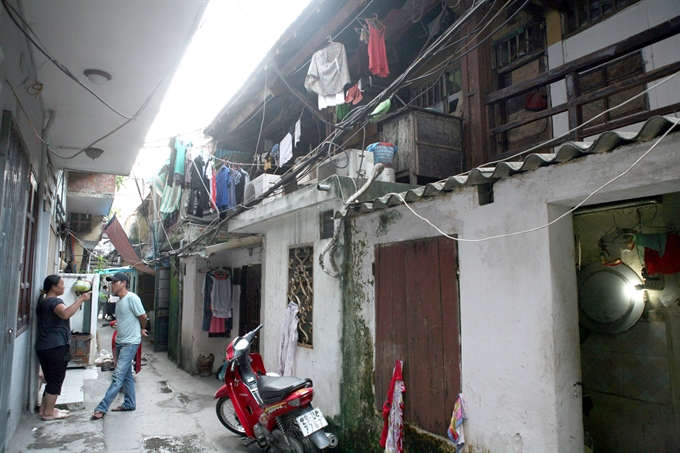 Society
Society

Thousands of households living on the corridor of (Hồng) Red River dyke system in Hà Nội will likely be moved as part of the flood prevention plan, authorities and experts have said.
 |
| Several old houses in Chương Dương Ward, Hoàn Kiếm District in Hà Nội which face a high risk of collapse in the event of a flood. Thousands of households living on the corridor of Red (Hồng) River dyke system in Hà Nội will likely be moved as part of the flood prevention plan. – VNA/VNS Photo Ngọc Hà |
HÀ NỘI – Thousands of households living on the corridor of (Hồng) Red River dyke system in Hà Nội will likely be moved as part of the flood prevention plan, authorities and experts have said.
The plan, recently approved by the Prime Minister, calls for renovating or relocating some 2,000 households along the river, which runs through Hà Nội’s wards of Chương Duong and Phúc Tân in Hoàn Kiếm District, Thanh Lương and Bạch Đằng in Hai Bà Trưng District, and Ngọc Thụy, Bồ Đề and Bát Tràng in Long Biên District, as well as other neighbouring areas of Võng La-Hải Bối, Đông Ngạc-Nhật Tảo, Bắc Cầu and Đông Ngàn.
Professor Hà Văn Khôi from the University of Water Resources spoke to Tiền Phong (Vanguard) newspaper, noting that the average water level continuously fell in the past decade, with the lowest recorded level of some 0.1m in 2010, creating favourable conditions for those households set a living along the river.
Meanwhile, a representative from the Bạch Đằng People’s Committee said these households were not included with the hundreds of illegal households built there since 1970.
The representative complained about the difficulties in relocating such households, as they were unprepared for the relocation and often seek to avoid cooperating with authorities.
Meanwhile, Dr Lê Viết Sơn from the Institute of Water Resources Planning said the new Government’s flood prevention planning scheme presented a very progressive subject, particularly for the population
residing outside the dyke system.
While providing prohibitions to those who violate the law on dyke protection or cause harm to dykes, the plan encourages households to reside and grow crops on islets or fertile lands along the river, according to the expert.
Earlier this year, Prime Minister Nguyễn Tấn Dũng approved a planning scheme for flood prevention and dyke systems along the Red and Thái Bình rivers.
The two rivers flow through 15 cities and provinces – Hà Nội, Hòa Bình, Hà Nam, Nam Định, Ninh Bình, Hưng Yên, Hải Dương, Thái Bình, Hải Phòng, Quảng Ninh, Phú Thọ, Vĩnh Phúc, Bắc Ninh, Bắc Giang and Thái Nguyên.
The plan aims to help the localities take the initiative in preventing floods and storms, contributing to their socio-economic stability as well as national security and defence.
It will also help relevant
ministries, agencies and localities manage efforts to prevent damage caused by floods and storms, and outline investment plans for related projects until 2030, with a vision towards 2050.
Apart from forecasting the flood tide in these areas, the scheme proposes anti-flood solutions and methods to effectively use river shores, in line with the Dyke Law and relevant legal documents, in the service of national socio-economic development. It further defines prioritised items and estimates resources necessary for the realisation of solutions.
From 2016-2030, efforts will be focused on planting administrative border markers along dyke corridors, completing operational procedures of large reservoirs located on the upper parts of the rivers, upgrading dykes, afforestation plans, as well as infrastructure and equipment supporting the work.
Many parts of Hồng and Thái Bình rivers in the north have seen its average water levels dramatically reduced – falling by 2m in 20 years. This has caused massive droughts among hundreds of thousands of hectares of farmland, blocked waterway transport and seriously polluted rivers. Experts said that the flow of the Hong River needs to remain at some 1,200 cubic metres per second to supply enough water for the Red River delta.
However, in the past several years the flow fell to 900 cu.m per second.
The River covers Hà Nội and 25 other provinces in the north, with a population of 26 million people and an agricultural area of nearly 1.1
million hectares. VNS